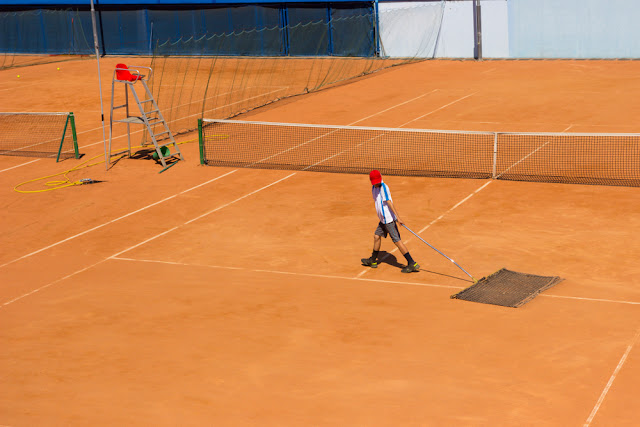The 5 Ball Controls
The objective of tennis in its most fundamental form is to:
"Make the little round, yellow, fuzzy ball, go where you need it to".
There are just 5 approaches to control the ball in tennis (Height, Direction,
Distance, Speed, and Spin)
Beginner:
Practice each ball control separately to enhance the ability to "read"
the ball. Begin with a 'mini-Tennis' rally, then advance to ¾ court, then baseline
to baseline. Height: Place a long brush
sweeper at the center of the net with bristles pointed up. Rally every ball
over the long brush like the net was higher. Direction: Player "A" begins points at any singles
sideline and serve the ball to player "B" who can hit to the open
court. Distance: Play points where
one or the other service boxes are out or a reward point is won if a player
misses a ball arrival in the service boxes.
Intermediate:
Players
at this level can play modified points with the emphasis on one Ball Control. Speed:
Player "A" begins points in ¾ court with a hard shot. In the event
that Player "B" defends well and wins, they get the opportunity to
start the succeeding point. Spin: Use a modified grasp (most of the way up the
racquet) to feel the racquet spinning the ball.
The 5 Phases of Play
USPTA Professional Mark Bey discusses the five phases of
play and the court positioning that accompanies them. The 5 periods of play are
given beneath:
The attacking phase
– in many cases inside the service box or even near the net. This stage
comprises of forceful overheads, swinging volleys, set away shots with expanded
racquet speed and descending directions.
The compelling phase
– otherwise called "a dead zone" – the balls in this stage are taken
early and hits driving, constraining shots. Illustrations can be second-serve
repays or short balls that you move in on.
The rally phase –
This includes hitting rally shots utilizing spin, pace and direction options while
working with shot precedents and trajectory to attempt to set up circumstances.
The counter-attacking phase
– This stage implies that your challenger has hit great shots and forced you
back. You are cooperating, contracting your swing to utilize the adversary's
pace or hitting a pitch to remain in the point.
The defensive phase
– In this stage you are stuck in an unfortunate situation, on your heels behind
the baseline, utilizing the mainland grip to extend and reach and get the ball
up to purchase time to recuperate.
Understanding the court position, utilizing the correct size
of circles and racquet head speed will help players settle on better choices
about shot selection and enhance their game plan. To find out more visit
Talbot Tennis. It is a platform that provides you with the construction, installation,
and maintenance of tennis court
. If you are looking for
tennis court builders, then we are the
right option.


